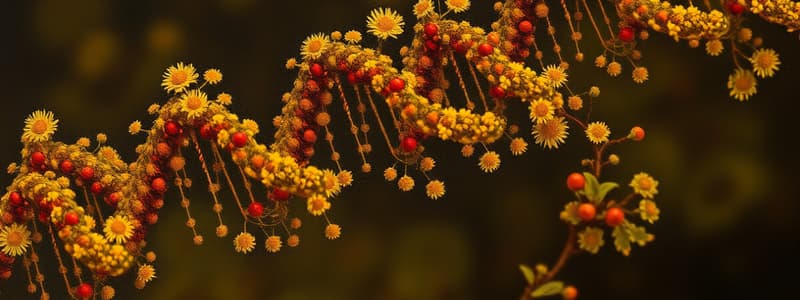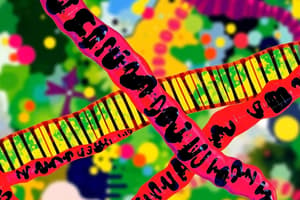Podcast
Questions and Answers
What is the primary role of general (basal) transcription factors?
What is the primary role of general (basal) transcription factors?
- To participate in the formation of the basal transcription complex (correct)
- To repress transcription
- To bind exclusively to enhancer regions
- To stimulate transcription of specific genes
Specific transcription factors can bind to regulatory sequences of any gene.
Specific transcription factors can bind to regulatory sequences of any gene.
False (B)
Define a transcription factor.
Define a transcription factor.
Any protein required to initiate or regulate transcription, other than RNA polymerase.
Transcription factors are identified to interact through specific amino acid side chains and base __________.
Transcription factors are identified to interact through specific amino acid side chains and base __________.
Approximately how many human transcription factors have been identified?
Approximately how many human transcription factors have been identified?
Match the following transcription factor types with their functions:
Match the following transcription factor types with their functions:
It takes approximately 10-20 weak interactions for a stable DNA-protein interface to form.
It takes approximately 10-20 weak interactions for a stable DNA-protein interface to form.
What is one mechanism by which transcription factors can achieve tissue-specific gene expression?
What is one mechanism by which transcription factors can achieve tissue-specific gene expression?
What is the purpose of spatio-temporal control of transcription factor expression?
What is the purpose of spatio-temporal control of transcription factor expression?
Mis-regulation of transcription factor expression does not impact health.
Mis-regulation of transcription factor expression does not impact health.
Name one method used to identify transcription factors.
Name one method used to identify transcription factors.
Transcription factors can be purified by affinity __________, using their property of binding specific DNA sequences.
Transcription factors can be purified by affinity __________, using their property of binding specific DNA sequences.
Match the methods with their functions in studying transcription factors:
Match the methods with their functions in studying transcription factors:
Which approach uses machine learning for binding site prediction?
Which approach uses machine learning for binding site prediction?
What is the primary function of homeodomain proteins?
What is the primary function of homeodomain proteins?
Zinc fingers consist of a structure maintained by Zn2+ ions.
Zinc fingers consist of a structure maintained by Zn2+ ions.
What determines the DNA binding specificity of homeodomain proteins?
What determines the DNA binding specificity of homeodomain proteins?
The leucine zipper forms a ____ helix due to the hydrophobic interactions among leucine residues.
The leucine zipper forms a ____ helix due to the hydrophobic interactions among leucine residues.
Match the following protein motifs with their functions:
Match the following protein motifs with their functions:
Which of the following correctly describes the structure of zinc fingers?
Which of the following correctly describes the structure of zinc fingers?
Substitution of leucine in the leucine zipper structure does not affect dimerization or DNA binding.
Substitution of leucine in the leucine zipper structure does not affect dimerization or DNA binding.
Name one example of a bHLH factor involved in muscle development.
Name one example of a bHLH factor involved in muscle development.
What role do enhancers and silencers play in gene regulation?
What role do enhancers and silencers play in gene regulation?
Housekeeping genes are only found in specific tissues.
Housekeeping genes are only found in specific tissues.
What determines the expression timing of tissue-specific genes?
What determines the expression timing of tissue-specific genes?
The _____ is a DNA-binding motif found in many transcription factors.
The _____ is a DNA-binding motif found in many transcription factors.
Match the structural motifs with their characteristics:
Match the structural motifs with their characteristics:
How does the action of multiple transcription factors typically affect transcription?
How does the action of multiple transcription factors typically affect transcription?
Insulators serve to promote interference to neighboring transcription units.
Insulators serve to promote interference to neighboring transcription units.
What are ubiquitous transcription factors?
What are ubiquitous transcription factors?
What is the primary role of transcription factors (TFs)?
What is the primary role of transcription factors (TFs)?
Transcription factors can only activate transcription but cannot repress it.
Transcription factors can only activate transcription but cannot repress it.
Name one enzyme that has histone acetylase activity.
Name one enzyme that has histone acetylase activity.
Transcription factors can also recruit __________ to the promoter to assist with transcription.
Transcription factors can also recruit __________ to the promoter to assist with transcription.
Match the transcriptional regulators with their functions:
Match the transcriptional regulators with their functions:
Which activity is NOT a mechanism used by transcription factors to influence transcription?
Which activity is NOT a mechanism used by transcription factors to influence transcription?
Histone acetylation typically promotes transcription.
Histone acetylation typically promotes transcription.
What is one effect of transcriptional repressors binding to DNA?
What is one effect of transcriptional repressors binding to DNA?
Flashcards are hidden until you start studying
Study Notes
Transcription Factors Overview
- Transcription factors (TFs) are proteins essential for initiating or regulating transcription, excluding RNA polymerase.
- Two categories:
- General (basal) factors contribute to the formation of the basal transcription complex at the transcription start site.
- Specific factors modulate transcription of particular genes through binding to regulatory sequences, influencing protein synthesis variability.
- Approximately 1,639 human transcription factors have been identified.
TF Binding and Mechanism
- Transcription factors bind to DNA via specific amino acid interactions, involving weak associations; a stable complex requires 10-20 interactions.
- Access to DNA is restricted due to nucleosome wrapping; TFs utilize chromatin remodelers to facilitate binding.
- Binding sites may contain multiple weak interactions; synergy exists when multiple TFs interact to activate genes.
- TFs often function as dimers to enhance binding specificity; they primarily exist as monomers in solution.
Cis-Regulatory Sequences
- Key elements include enhancers and silencers located far from promoters, which facilitate or inhibit transcriptional activity.
- Insulators are present to prevent unintended interactions between nearby transcription units.
Housekeeping Genes
- Housekeeping genes exhibit consistent expression across all cell types, featuring binding sites for ubiquitous TFs.
- Activators work additively in non-linear fashion; e.g., if TF A increases transcription two-fold and TF B ten-fold, their combined effect can boost transcription significantly.
Tissue-Specific Genes
- Feature binding sites for both ubiquitous and tissue-specific TFs, example: globin genes interact with factors like SP1 and GATA-1.
- The context determines binding specificity; combinatorial control at the pre-initiation complex (PIC) decides gene expression outcomes.
Structural Motifs Classifying TFs
- Four primary structural motifs used to classify TFs:
- Helix-turn-helix: Found in both prokaryotic and eukaryotic TFs; recognition helix binds in major groove.
- Zinc fingers: Stabilized by Zn2+; diverse with multiple variations; example includes nuclear receptors.
- Leucine zippers: Characterized by leucine every seventh amino acid; forms dimers for specific DNA positioning.
- Helix-loop-helix: Involves dimerization; plays significant roles in muscle development and neurogenesis.
Mechanisms of TF Activation and Repression
- Activators interact with general TFs or RNA polymerase II to initiate transcription.
- Some TFs remodel chromatin structure via recruitment of histone-modifying enzymes (HATs and HDACs).
- Repression can occur by blocking activators or interfering with transcriptional complexes.
Regulated Expression of TFs
- Spatial and temporal control over TF expression is crucial for diverse gene-expression patterns across cell types.
- Misregulation can lead to diseases or malformations in development.
Experimental Methods for Investigating TFs
- Protein purification: Uses affinity chromatography to isolate TFs based on their DNA-binding capabilities.
- Footprinting techniques: Identify where TFs bind DNA by observing protected regions against nucleases.
- Reporter gene assays: Measure transcriptional activity in response to specific TFs.
- ChIP or CUT and RUN: Techniques for analyzing TF binding across the genome.
- Knock-down assays: Analyze transcriptional changes following the deletion of specific TFs.
- Machine learning and AI: Used for predicting TF DNA-binding motifs and their functions based on structural homology.
Studying That Suits You
Use AI to generate personalized quizzes and flashcards to suit your learning preferences.



